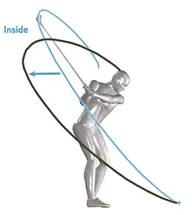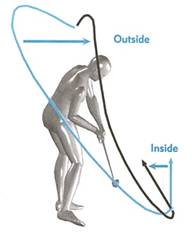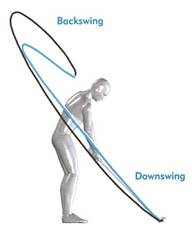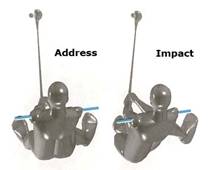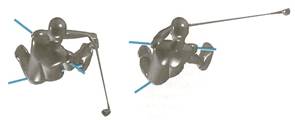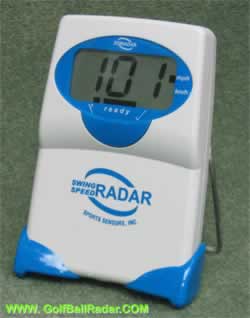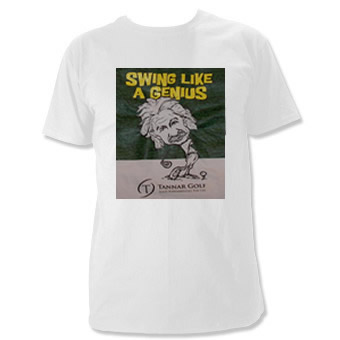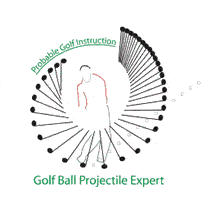
|
|
|
Downswing -- Maintain Angles
From the top of the backswing, the downswing is initiated by the lower body with a rotation of the hips and gradual shifting of the weight to the front leg. In fact, with many good players, this lower body rotation begins even before the club reaches its highest position in the backswing. Thus, it's important that the transition between backswing and downswing occur slowly, and only with the lower body, not the arms and hands. In fact, the transition should take about 20% of the entire time from takeaway to impact. The downswing is led by the large muscles of the legs and the mid-section (abdomen). These muscles, although much stronger than the arms/hands, move more slowly and thus require more time to react. As the legs initiate the downswing, the forward foot begins to plan itself firmly on the ground. Try the Step Drill: #3
Ideally, the club travels along approximately the same plane on the way down as on the up. A number of very good golfers actually have a slightly flatter downswing plane. They achieve this through a strong lower body rotation which drops the arms and club down.
On the other hand, many amateur golfers initiate the downswing with the arms and upper body, which moves the arms and club more outwards, creating and outside-to-inside swing path.
This move also puts the club in a position from which it is hard to release (close the club face), thus the face is left open. The result is a slice. If one initiates the downswing well with a strong lower body rotation, the club will follow a swing plane very close to the backswing swing plane. The club path will be from inside the target line to along the target line to inside the target line.
The body should be in positioned similarly to the way it was at address except that:
• The hips are open, facing partially towards the target. • Most of the weight is on the front leg and on the middle to outside of the front foot. • The forward knee will flexed towards the target. • The hands are farther ahead of the ball.
A good backswing will get the club into a powerful position from which the downswing can deliver a powerful, accurate move that generates ample clubhead speed in the proper direction. The backswing has 3 fundamental stages: • One Piece Takeaway to 9 o'clock • Hinging of the Wrists & the Rotating Coil • Setting of the Club at the Top
One Piece Takeaway to 9 o'clock The most important aspect of the full swing is rotation. The body must rotate about a solid foundation to put itself in a strong position to deliver the club to the ball. This rotation begins immediately in the backswing with the one piece takeaway. It's important that the club be taken back in a one-piece movement to the 9 o'clock position in that there is little wrist cock and no lifting of the club, just rotation of the shoulders and spine. Visualize your arms and shoulders forming a triangle, as in the photos. In a one-piece takeaway, the triangle does not change significantly. A goal would be for the triangle to not change at all.
The club should travel a path low to the ground during the takeaway. Attempt to keep the club along the target line for about the first foot of the takeaway and then gradually inside the target line. By just focusing on rotating the shoulders about the spine, this movement should occur quite naturally. The clubhead should remain low to the ground as it follows the path of a circle, with a center point around the base of the neck. Another way of thinking of the one piece takeaway is to think of taking the entire club away as a single unit , so that the butt end of the club and the clubhead move away at approximately the same speed. A golfer should avoid having the clubhead end of the club moving much faster than the grip end - due to excessive independent wrist motions occurring during the takeaway. The club's path should be along a circular arc, as it is rotating about the rotating body. Many amateurs make the mistake of picking the club up too abruptly, so that the path is more of a straight line than a circle. The takeaway to 9 o'clock position is the slowest part of the swing, taking about 40% of the total time from takeaway to impact.
At the end of the takeaway, the 9 O'Clock position, the club is parallel to the ground and parallel to the target line. There has been very little hinging of wrists. The club face has rotated about 90 degrees. This rotation is the result of the body rotating about the spine (via the shoulder turn) and the arms rotating slightly, changing the triangle slightly.
Hinging of the Wrists & the Rotating Coil
The latter part of the backswing consists of a continued rotation of the shoulders and body. Some think of it as a coiling spring, in which the muscles of the back get stretched and thus store energy, later to be delivered to the ball. More realistically, however, the body is positioning itself in a powerful position from which to rotate back and deliver the club to the ball.
As the body continues to rotate and coil, the arms carry the club up to its highest position. As long the hands, wrists and arms are relaxed (not gripping too hard), the wrists will naturally hinge or cock due to the weight of the club. How far back the club travels in the backswing depends on the flexibility of the golfer. A longer backswing doesn't always mean a longer golf ball, however. Some golfers will get to the club to the 3 or 4 o'clock position and others only to the 1 or 2 o'clock position. I'll send you a Wrist Set Drill in the next email.
As the body coils and rotates, it requires a supportive base that offers stability and resistance to the coil. This is provided by the right leg. It's important that it remain in the same position as it was at address, with the weight being supported as much as possible by the inside of the foot. Note the right leg position between set-up and top of the backswing with this famous golfer.
Note the position of the left shoulder at the top of the backswing, relative to its position at address. It has moved rearwards, shifting the balance of the weight to the rear leg, which is firmly braced. This is a very powerful position, resulting from a full shoulder rotation about the spine. Try the Brace Drill -- Rear Leg Foundation The purpose of this drill is to give your rear leg the correct feeling of weight distribution so that it remains a solid foundation during the backswing and downswing. • Place a folded towel or piece 1 inch thick wood under the outside of the rear foot. This will cause the ankle to roll inwards distributing the weight onto the inside of the foot. You could even use a golf ball.
• Take some swings feeling the sensation of the weight transferring to the inside of the rear foot. You can even hit some balls. • The rear leg knee should remain flexed slightly throughout the swing.
It's important that during the backswing the spine angle (amount of tilt of the spine) remains constant. Just as one needs a solid rear leg brace for support, one also needs a constant rotating axis.
Go to this page to learn a method of aligning using an intermediate target. CLICK HERE To learn more about Intermediate Focus Golf, CLICK HERE
Want to view other lessons in this series thus far. Click on the link below. Lesson #1: Golf Grip -- The Connection Lesson #2: Golf Stance & Set-up -- The Foundation Lesson #3: Golf Swing Plane -- The Swing Slot Lesson #4: Golf Swing Weight Transfer -- The Athletic Move Lesson #5: Golf Swing BackSwing -- The Takeaway & Coil
©Probable Golf Instruction, Ken Tannar 2001-2015. All Rights Reserved. Langley, B.C. V2Y 2G4 CanadaPhone: 604-309-7030 FAX: to fax, email an attachment probablegolf@yahoo.ca or golfexpert@probablegolfinstruction.com |
| GOLF ASSISTANTS |
|
Golf Trip Pairing CalculatorPlanning a golf trip with some friends/family? Trying to sort out the foursomes so people don't play too often with others? Order your ready made Spreadsheet. Type in the names, print out the groupings. Minimize repeat pairings.
Wind Caddy will advise you on aim, distance and club so that you can play the wind successfully. It takes the guess work out of club selection. New option to enter custom distances for each club. The algorithm will make a club suggestion accordingly. Use the right club in every condition!
|
|
|
| GOLF NEWS |
Golf Putting Green Reading Glasses |
| GOLF NEWSLETTER |
Statistics
·Putting
·Long Balls
·Games
·Handicap
·Scoring
·Shot Patterns
·Tournaments
·Tours
Pro Shop
·Ball Marker Engraved
·Books
·CDs & DVDs
·Green Reader
·Impact Labels
·Laser Rangefinder
·Longer Drives
·Products
·Teaching Aids
|
|
| GOLF POLL |
The 19th Hole
·Advertising
·Ask the Golf Expert
·Consultation/Litigation
·FAQs
·Golf Blog
·Golf Draws
·Links
·Science of Golf
·Tell a Friend
·Testimonials
·

Golf Ball Finder Glasses
Find all your errant golf balls and many more!
| GOLF TIPS |
How to play:
|

